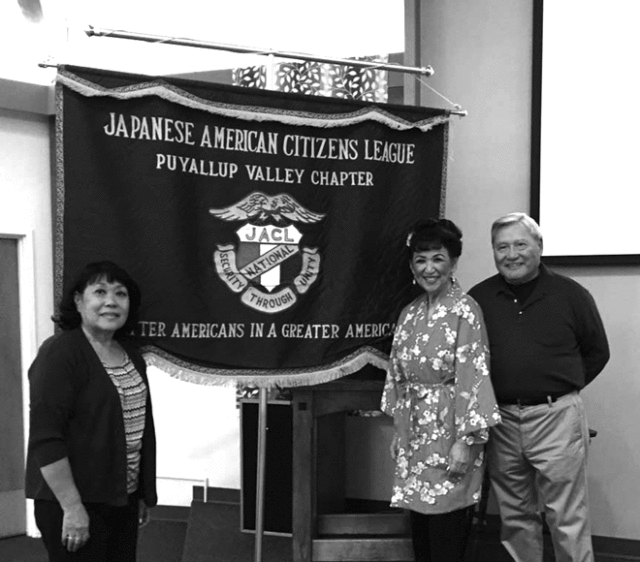By Tamiko Nimura
For The North American Post
Every September, thousands of people “do the Puyallup.” For Washington State residents it is an opportunity to visit the State Fairgrounds, ride the rollercoasters, listen to concerts and eat scones with raspberry jam.
For other visitors, including the Camp Harmony Committee (CHC), the memories and associations with the site are not always so pleasant. During World War II, the site housed over seven thousand Japanese Americans, serving as a detention center for Nikkei evacuated from Alaska, Seattle, Tacoma,and surrounding rural areas. It became known as “Camp Harmony,” nicknamed by army public relations officials. For these visitors, a corner of the fairgrounds marks a crucial link to the history of the site, the state and the nation.

In 2017, the 75th anniversary of the signing of Executive Order 9066, going to the Fair will carry a special historical dimension. On September 2, the Camp Harmony Committee plans to honor the textured history of the Fairgrounds by rededicating “Harmony,” a 10-foot silicon-bronze George Tsutakawa memorial sculpture located in a small corner of the Fairgrounds.
“The Washington State Fair has recently upgraded the area around the Harmony sculpture to make it a peaceful and reflective area of the fairgrounds. What is missing is the description and purpose of ‘Harmony’ in George Tsutakawa’s own words,” says Eileen Yamada Lamphere, public information officer for the CHC. “The words are eloquent and reflects George’s purpose and mission of the work. With the Tsutakawa family blessing, we would like to install George’s words…to rededicate the sculpture for the future and future fairgoers.” Plans for the rededication include a few cultural and educational activities, including a keynote talk by Tom Ikeda, director of Densho. Both sets of Ikeda’s grandparents were incarcerated at Camp Harmony.
Describing itself as a “small but mighty” committee, the CHC focuses on educational presentations in and around Washington State. It is funded by the Puyallup River JACL, but includes many members and supporters representing multiple Nikkei generations and local stakeholder populations: “people who are all deeply committed to this project and the legacy of the Japanese American wartime experience,” says Yamada Lamphere. Members and supporters of the CHC include local elected officials, historians, museum administrators and educators. Its work serves an important but often-overlooked niche in camp history: the experience of rural Nikkei populations.
At the heart of the CHC’s work is a traveling presentation featuring two Nisei speakers, Elsie Yotsuuye Taniguchi and Cho Shimizu. Taniguchi and Shimizu were both incarcerated at Camp Harmony as children. During their presentations, they address their memories and the aftereffects of their incarceration. The CHC has made a few presentations, including a recorded one at the Federal Way United Methodist Church; in April 2016, they are scheduled to present at the Washington State History Museum.
The cross-generational aspect of the CHC’s work is particularly significant for its members. Shimizu lists his grandchildren and relatives as paramount reasons for his work on the Committee, so that they “know the story of the way it was. And [to] make sure this history and how it affected the people by an unjust decision based on fear, politics and hysteria never happen again.” For Yamada Lamphere, the CHC’s educational presentations also help build a cross-generational understanding of her parents: “As a sansei, I was born after the time, while my parents were rebuilding their lives, trying to acculturate and assimilate into post war America. Their belief was that if we lived our lives as ‘true’ Americans, as defined by the majority, we would be accepted…They did not realize that this face would be ‘forever foreign.’”
Taniguchi’s cross-generational understanding flows backwards and forwards in time: “I truly appreciate all of the sacrifices my Grandparents and Parents made in order for my Sansei generation and Yonsei and Gosei generation… I now understand what painful experiences my ancestors went through and why they did not want to talk about it. It is even painful for me to share some of their stories, but I realize it is now my responsibility to reach out and share our family experiences.”
The Committee’s work has been transformational for many involved, including the Nisei speakers. “I continue to learn and realize the importance of what we do,” says Shimizu. “My life has changed in dealing with people and am developing more confidence in myself in dealing with the public, something I didn’t have in the past.” Taniguchi agrees: “The more I learn and share,” she says, “the more I realize how important it is to share our information before we depart from this earth.”
Even after the 2017 event, the CHC plans to continue its focus on education, mainly through presentations to community groups and schools. It hopes to have its presentation travel to other small towns and places in Washington State where Japanese American populations may not have been present. “There were over 120,000 locked behind barbed wire,” says Yamada Lamphere, “and there are over 120,000 stories, unique, special, and should never be forgotten.”

* * * * *
The Camp Harmony Committee is presenting “Remembering Camp Harmony,” featuring Elsie Taniguchi and Cho Shimizu, at the Washington State History Museum on April 26 at 12 p.m. The event is free with museum admission. Donations to the Committee’s work may be earmarked as “Camp Harmony Committee,” “September 2017 event,” or “Harmony” sculpture, sent to the Puyallup River JACL. More information on the committee’s work, donations and events can be found through Eileen Yamada Lamphere (elamphere@hotmail.com).
Editor’s note: The article was originally published in Discover Nikkei at www.discovernikkei.org managed by the Japanese American National Museum. Tamiko Nimura is a Sansei/Pinay writer originally from Northern California and now living in the Pacific Northwest. She blogs at Kikugirl.net and is working on a book project that responds to her father’s unpublished manuscript about his Tule Lake incarceration during World War II.








